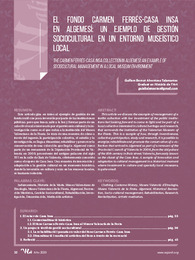Please use this identifier to cite or link to this item:
https://hdl.handle.net/11000/7707Full metadata record
| DC Field | Value | Language |
|---|---|---|
| dc.contributor.author | Alventosa Talamantes, Guillem Bernat | - |
| dc.date.accessioned | 2021-05-11T08:46:10Z | - |
| dc.date.available | 2021-05-11T08:46:10Z | - |
| dc.date.created | 2020-01-02 | - |
| dc.date.issued | 2021-05-11 | - |
| dc.identifier.issn | 2659-5362 | - |
| dc.identifier.uri | http://hdl.handle.net/11000/7707 | - |
| dc.description.abstract | Este artículo gira en torno al ejemplo de gestión de un fondo textil con poca inversión por parte de las instituciones públicas, pero que busca salir a la luz y formar parte de un colectivo local e interesado por el patrimonio cultural y la investigación como es el que rodea a la institución del Museo Valenciano de la Fiesta. Se trata de una muestra de cómo a través del ingenio, la participación colectiva, el estudio y la investigación, se llega a dinamizar, rehabilitar y promover la conservación de una colección que llegó a Algemesí como parte de un remanente de la Diputación Provincial de Valencia en 2009, procedente del antiguo palacete del siglo XVI en la calle de Baix de Valencia, célebremente conocido como el ropero de Casa Insa. Una muestra de innovación y adaptación a la gestión cultural en un momento histórico, donde la inversión en cultura y más en los museos locales, es bastante reducida | es |
| dc.description.abstract | This article we discuss the example of management of a textile collection with low investment of the public institutions but looking forward to come to light and be part of a local collective interested in cultural heritage and research, that surrounds the institution of the Valencian Museum of the Fiesta. This is a sample of how, through inventiveness, collective participation, study and research, it is possible to energize, rehabilitate and promote the conservation of a collection that arrived to Algemesí as part of a remnant of the Provincial Council of Valencia in 2009, from the old palace of the 16th century in Baix street, Valencia, famously known as the closet of the Casa Insa. A sample of innovation and adaptation to cultural management in a historical moment where investment in culture and specially local museums, is quite small. | es |
| dc.format | application/pdf | es |
| dc.format.extent | 12 | es |
| dc.language.iso | spa | es |
| dc.relation.ispartofseries | 2 | - |
| dc.rights | info:eu-repo/semantics/openAccess | es |
| dc.subject | Indumentaria | es |
| dc.subject | Historia de la Moda | es |
| dc.subject | Museo Valenciano de Etnología | es |
| dc.subject | Museo Valenciano de la Fiesta | es |
| dc.subject | Algemesí | es |
| dc.subject | Recreación histórica | es |
| dc.subject | Gestión sociocultural | es |
| dc.subject | Rehabilitación | es |
| dc.subject | Investigación | es |
| dc.subject | Dinamización | es |
| dc.subject | Mediación artística | es |
| dc.subject.other | CDU::3 - Ciencias sociales::39 - Etnología. Etnografía. Usos y costumbres. Tradiciones. Folklore | es |
| dc.title | El fondo Carmen Ferrés-Casa Insa en Algemesí: Un ejemplo de gestión sociocultural en un entorno museístico local | es |
| dc.type | info:eu-repo/semantics/article | es |

View/Open:
4-1351-Texto del artículo-5699-1-10-20210423.pdf
3,47 MB
Adobe PDF
Share:
.png)
